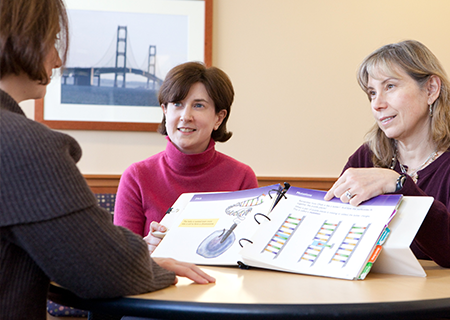BRCA Gene Mutations and Cancer

contributed by Mark Pearlman, M.D., Department of Obstetrics/Gynecology
Two genes, BRCA1 and BRCA2, if mutated are known to dramatically increase a woman’s risk of developing breast and ovarian cancer. Men can also carry these genes, and if they have a gene mutation, which also puts them at risk for developing breast and other cancers, though their breast cancer risk is not nearly as much as in women. These mutations are so-called germline mutations, that is, they are acquired at conception from either their mother or father. If a parent has a BRCA gene mutation, each child has a 50 percent likelihood of acquiring that mutation. Each year, a group called the National Comprehensive Cancer Network, reviews the latest research and develops the guidelines of who should be tested for these gene mutations.
Current guidelines recommend genetic screenings for:
- women and men who have a strong family history of breast and/or ovarian cancer on either the maternal or paternal side of their family
- women and men who developed breast cancer, particularly bilateral breast cancer, at a young age (under age 50)
- women who developed ovarian cancer at a young age
- women who have men in the family with breast cancer
The screening is a simple blood test, but it is expensive (around $4,000) and, due to patent restrictions, is performed by only one lab in the United States. For that reason, we must conserve resources and only test those individuals who meet the testing criteria.
Individuals who carry the BRCA1 gene mutation have a 60% to 85% chance of developing breast cancer and an approximately 40% chance of developing ovarian cancer. Those with the BRCA2 gene have 40% to 60% chance of developing breast cancer and about a 20% chance of developing ovarian cancer. After learning you have one of these gene mutations, there are several decisions to make.
At a minimum, women with BRCA gene mutations should undergo aggressive surveillance. This typically consists of an annual mammogram and breast MRI starting at age 25. This allows us to detect breast cancers sooner, if it does develop, at an early and more treatable stage. Like Ms. Jolie, some patients choose the risk-reduction bilateral mastectomy and breast reconstruction, which reduces their risk of developing breast cancer by 93%. However, there is no data currently that compares the mortality rate of those who choose bilateral mastectomy versus those who opt for aggressive screening.
Unfortunately, we currently do not have reliable surveillance methods for early diagnosis of ovarian cancer that are as effective as mammograms and breast MRI are for breast cancer. For women who have the BRCA1 or BRCA2 gene mutation, we do recommend removal of their ovaries and fallopian tubes after they are done having children, typically between the ages of 35 and 40.
If you feel you may be at an increased risk for carrying one of these genes, it’s important to discuss your family history with your healthcare provider. He or she can recommend a course of action. For those who find they have either the BRCA1 and BRCA2 gene, the University of Michigan Rogel Cancer Center has a wealth of resources to help you understand your options.
